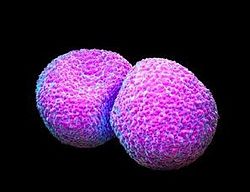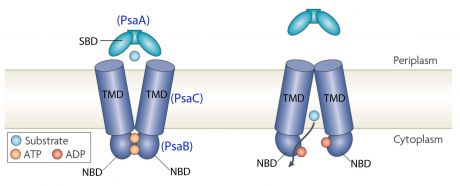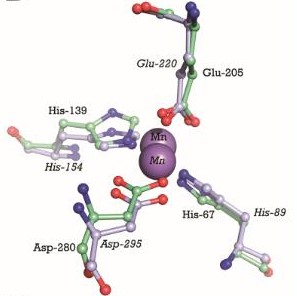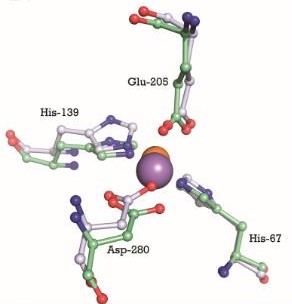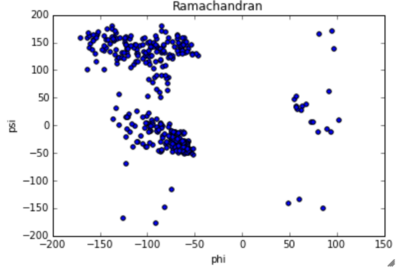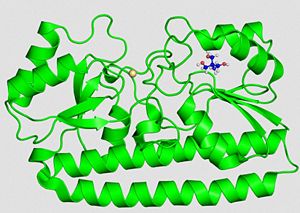Elizeu/sandbox/citocromo c
From Proteopedia
(Difference between revisions)
| Line 8: | Line 8: | ||
'''PDB ID''': 3ZK7 | '''PDB ID''': 3ZK7 | ||
| - | <StructureSection load='3zk7' size=' | + | <StructureSection load='3zk7' size='350' color='white' side='right' frame='true' caption='3D structure of PsaA in the metal-free, open state (PDB: [http://www.rcsb.org/pdb/explore.do?structureId=3zk7 3zk7])' > |
| + | |||
== Overview == | == Overview == | ||
| - | PsaA (Pneumococcal surface antigen A) is a high affinity substrate-binding lipoprotein <ref name="ref5">http://www.uniprot.org/uniprot/P0A4G2</ref> detected on all known serotypes of [https://en.wikipedia.org/wiki/Streptococcus_pneumoniae ''Streptococcus pneumonia'']. It facilitates the acquisition of | + | [[Image:streptococcus pneumoniae.jpg | 250px|thumb| ''Streptococcus pneumoniae'' <ref>http://www.sciencephoto.com/images/download_lo_res.html?id=662360183</ref>]] PsaA (Pneumococcal surface antigen A) is a high affinity substrate-binding lipoprotein <ref name="ref5">http://www.uniprot.org/uniprot/P0A4G2</ref> detected on all known serotypes of [https://en.wikipedia.org/wiki/Streptococcus_pneumoniae ''Streptococcus pneumonia'']. It facilitates the acquisition of Mn<sup>2+</sup> by being part of the cell's [https://de.wikipedia.org/wiki/ABC-Transporter ABC (ATP binding cassette) transporter] and plays a major role in pneumococcal attachment to the host cell and [https://en.wikipedia.org/wiki/Virulence virulence] <ref>PMID:25786639</ref>. |
| - | + | ||
| - | + | ||
| - | + | ||
| - | + | ||
| - | + | ||
| - | + | ||
| - | + | ||
| - | + | ||
| - | + | ||
| - | + | ||
| - | + | ||
| - | + | ||
| - | + | ||
| - | + | ||
| - | + | ||
| - | + | ||
| - | + | ||
| + | ''Streptococcus pneumoniae'', also widely known as pneumococcus, is a Gram positive coccus with a diameter of 0.5 to 1 μm. As a member of the genus ''Streptococcus'' it typically forms diplococci and can live both under aerobic or anaerobic conditions. In healthy carriers it resides in the nasopharynx <ref name="ref4">PMID:4366526</ref>. However, the bacterium may become pathogenic in elderly and [https://en.wikipedia.org/wiki/Immunodeficiency immunocompromised] people as well as in children due to a weaker immune system. In fact, ''S. pneumoniae'' is the most frequent opportunistic pathogen worldwide and causes many types of diseases including [https://en.wikipedia.org/wiki/Otitis_media otitis media], [https://en.wikipedia.org/wiki/Meningitis meningitis], [https://en.wikipedia.org/wiki/Sepsis sepsis] and [https://en.wikipedia.org/wiki/Pneumonia pneumonia] <ref>PMID:26379256</ref>. The genome of ''S. pneumoniae'' is a closed, circular DNA structure that contains between 2.0 and 2.1 million base pairs <ref name="ref4" />. | ||
| Line 37: | Line 22: | ||
Zinc in excess has a significant toxicity to bacteria because it is an important innate defense mechanism. There are many Zinc molecules in the human body. Manganese is important for the virulence, growth and proliferation of ''Streptococcus pneumoniae''. Zinc could compete for Manganese binding. However Manganese has more affinity for PsaA than Zinc but Zinc is not transported by the ABC-transporter. Zinc competition reduces intracellular Manganese resulting in up-regulation of PsaBCA expression. <ref>PMID:22072971</ref> | Zinc in excess has a significant toxicity to bacteria because it is an important innate defense mechanism. There are many Zinc molecules in the human body. Manganese is important for the virulence, growth and proliferation of ''Streptococcus pneumoniae''. Zinc could compete for Manganese binding. However Manganese has more affinity for PsaA than Zinc but Zinc is not transported by the ABC-transporter. Zinc competition reduces intracellular Manganese resulting in up-regulation of PsaBCA expression. <ref>PMID:22072971</ref> | ||
| - | [[Image:PsaA dans ABC transporteur.jpg |500px| Structure of ABC-transporter <ref>http://www.latrobe.edu.au/biochemistry-and-genetics/research/maher/psabca-manganese-uptake-by-streptococcus-pneumoniae</ref>]] | + | [[Image:PsaA dans ABC transporteur.jpg |500px|thumb| Structure of ABC-transporter <ref>http://www.latrobe.edu.au/biochemistry-and-genetics/research/maher/psabca-manganese-uptake-by-streptococcus-pneumoniae</ref>]] |
===ABC transporter=== | ===ABC transporter=== | ||
| - | [https://en.wikipedia.org/wiki/ATP-binding_cassette_transporter | + | Bacterial [https://en.wikipedia.org/wiki/ATP-binding_cassette_transporter ABC transporters] are an important class of transmembrane proteins. They are involved in the import and export of a wide variety of substrates, including sugars, amino acids, peptides, [https://en.wikipedia.org/wiki/Polyamine polyamines], and cations <ref>PMID:2715661</ref>. They can be considered as a promising target for antimicrobial strategies. ABC transporters consist of four membrane-associated proteins with two ATP-binding proteins ([https://en.wikipedia.org/wiki/ATPase ATPases]) and two [https://en.wikipedia.org/wiki/Permease permeases]. <ref>http://webcache.googleusercontent.com/search?q=cache:3MvkKDHQVzwJ:www.omicsonline.com/open-access/role-of-abc-transporter-proteins-in-stress-responses-of-streptococcus-mutans-2247-2452.1000592.pdf+&cd=1&hl=fr&ct=clnk&gl=fr&client=firefox-b </ref> |
| - | In the case of [https://www.wikigenes.org/e/gene/e/2717000.html | + | In the case of [https://www.wikigenes.org/e/gene/e/2717000.html PsaA], the ABC transporter is composed of an ATP-binding protein (''PsaB''), an integral membrane protein (''PsaC'') and PsaA itself as a [https://en.wikipedia.org/wiki/Lipoprotein lipoprotein] that possess a metal-ion binding site. This confers the protein to bind divalent metal-ions, however, with a preference for Mn<sup>2+</sup> <ref>PMID:18340341</ref>. |
| - | The genes that encode for the components of the ABC transport system are ''psaA'', ''psaB'' and ''psaC'', respectively. They are organized consecutively in the psaBCA operon, together with psaD, the gene encoding for a thiol peroxidase (see below). <ref name="ref3">PMID:517531</ref>.[[Image:operon psa.jpg |500px| thumb| | + | The genes that encode for the components of the ABC transport system are ''psaA'', ''psaB'' and ''psaC'', respectively. They are organized consecutively in the psaBCA operon, together with ''psaD'', the gene encoding for a [thiol peroxidase] (see below). <ref name="ref3">PMID:517531</ref>.[[Image:operon psa.jpg |500px| thumb| PsaBCA operon <ref>PMID:15255900</ref>]] |
| Line 54: | Line 39: | ||
== Structure == | == Structure == | ||
The protein PsaA has a molecular weight of 34.538 kDa with 309 residues <ref>https://www.mybiosource.com/prods/Recombinant-Protein/Manganese-ABC-transporter-substrate-binding-lipoprotein-psaA/psaA</ref>. The overall size of the protein approximated from its crystal structure is 40 by 40 by 70 Å <ref name="ref1">PMID:28011228</ref>. | The protein PsaA has a molecular weight of 34.538 kDa with 309 residues <ref>https://www.mybiosource.com/prods/Recombinant-Protein/Manganese-ABC-transporter-substrate-binding-lipoprotein-psaA/psaA</ref>. The overall size of the protein approximated from its crystal structure is 40 by 40 by 70 Å <ref name="ref1">PMID:28011228</ref>. | ||
| - | As a member of the Lipoprotein receptor-associated antigen I (LraI) family, the PsaA molecule contains four distinct regions. An N-terminal leader sequence of 20 amino acids holds an LxACy consensus sequence that is recognized and cleaved by signal peptidase II <ref name="ref1" />. A lipid moiety (diacylglycerol <ref name="ref2">PMID:99024</ref>) is added to the cysteine residue and mediates the anchorage of the protein to the cytoplasmic membrane. Apart from this leader sequence, the rest of the protein consists of two fold-pseudosymmetrical (β/α)4 sandwich domains, of which the β-strands of each domain form parallel β-sheets <ref name="ref2" />. In total the two domains form two lobes connected via an α-helical linker which constitutes the solute-binding site <ref name="ref1" />. | + | As a member of the Lipoprotein receptor-associated antigen I (LraI) family, the PsaA molecule contains four distinct regions. An N-terminal leader sequence of 20 amino acids holds an LxACy consensus sequence that is recognized and cleaved by signal peptidase II <ref name="ref1" />. A lipid moiety (diacylglycerol <ref name="ref2">PMID:99024</ref>) is added to the cysteine residue and mediates the anchorage of the protein to the cytoplasmic membrane. Apart from this leader sequence, the rest of the protein consists of two fold-pseudosymmetrical (β/α)<sub>4</sub> sandwich domains, of which the β-strands of each domain form parallel β-sheets <ref name="ref2" />. In total the two domains form two lobes connected via an α-helical linker which constitutes the solute-binding site <ref name="ref1" />. |
'''Secondary structure of PsaA:''' | '''Secondary structure of PsaA:''' | ||
| - | [[Image:structure secondaire.jpg | | + | [[Image:structure secondaire.jpg |1000 px|center| thumb]] <ref name="ref5" /> |
| - | '''Ramachandran blot:''' | ||
| - | The ramachandran blot of PsaA has been obtained by Lovell, Davis, et al. Proteins 50:437. | ||
| - | [[Image:ramachandran.png]] | ||
We can see on the right, the 3D structure of PsaA protein. We can observe that there are <scene name='55/559112/3zk7_tris/1'>TRIS molecules</scene>(TRIS significate 2-AMINO-2-HYDROXYMETHYL-PROPANE-1,3-DIOL). | We can see on the right, the 3D structure of PsaA protein. We can observe that there are <scene name='55/559112/3zk7_tris/1'>TRIS molecules</scene>(TRIS significate 2-AMINO-2-HYDROXYMETHYL-PROPANE-1,3-DIOL). | ||
| Line 74: | Line 56: | ||
| [[Image:details psaa avec mn.jpg]] | | [[Image:details psaa avec mn.jpg]] | ||
| [[Image:details psaa avec zn.jpg]] | | [[Image:details psaa avec zn.jpg]] | ||
| + | | [[Image:ramachandran.png|400 px|right| thumb| Ramachandran blot of PsaA obtained by Lovell, Davis, ''et al.'' Proteins 50:437]] | ||
|} | |} | ||
| - | This image shows the metal binding site in more detail, with the MntC residues and Manganese. | + | This image shows the metal binding site in more detail, with the MntC residues and Manganese. Manganese ions are shown as purple spheres. We can see that Manganese interacts with Histine residues, Aspartique acid residues and Glutamique acid residues. |
The metal binding site is formed by the sidechains of residues His67, His139, Glu205, and Asp280. This site has tetrahedral coordination geometry. The amino acids His67 andHis139 interact with the metal via Nε2 nitrogen atoms. However, the carboxylate sidechains of Glu205 and Asp280 interact with the metal via their Oε1 and Oδ2 atoms. The atomic distance between His67 Nε2 and the metal is 1.99 Ắ while it is 2,01 Ắ for His 139 Nε2. It is 2,04 Ắ for Glu205 Oε1 and 2,02 Ắ for Asp280 Oδ2. The Oδ1 atom of Asp137 can form a hydrogen bond with Nδ1 of His139. Oδ1 atom of Asp65 can also form a hydrogen bond with His67 N. <ref>PMID:9862808</ref> | The metal binding site is formed by the sidechains of residues His67, His139, Glu205, and Asp280. This site has tetrahedral coordination geometry. The amino acids His67 andHis139 interact with the metal via Nε2 nitrogen atoms. However, the carboxylate sidechains of Glu205 and Asp280 interact with the metal via their Oε1 and Oδ2 atoms. The atomic distance between His67 Nε2 and the metal is 1.99 Ắ while it is 2,01 Ắ for His 139 Nε2. It is 2,04 Ắ for Glu205 Oε1 and 2,02 Ắ for Asp280 Oδ2. The Oδ1 atom of Asp137 can form a hydrogen bond with Nδ1 of His139. Oδ1 atom of Asp65 can also form a hydrogen bond with His67 N. <ref>PMID:9862808</ref> | ||
| Line 84: | Line 67: | ||
This image shows the metal binding site in more detail, with MntC residues and Managanese and Zinc. Manganese ion is shown as a purple sphere and Zinc ion is shown as an orange sphere. Cadmium uptake reduces the millimolar cellular accumulation of manganese and zinc, and thereby increases sensitivity to oxidative stress <ref>http://www.nature.com/articles/ncomms7418</ref>. | This image shows the metal binding site in more detail, with MntC residues and Managanese and Zinc. Manganese ion is shown as a purple sphere and Zinc ion is shown as an orange sphere. Cadmium uptake reduces the millimolar cellular accumulation of manganese and zinc, and thereby increases sensitivity to oxidative stress <ref>http://www.nature.com/articles/ncomms7418</ref>. | ||
| - | [[Image:molec.jpg|left| | + | [[Image:molec.jpg|left|300px | thumb| "3D structure of PsaA with 2-AMINO-2-HYDROXYMETHYL-PROPANE-1,3-DIOL (tris) and cadmium<ref>http://www.ebi.ac.uk/pdbe/entry/pdb/4UTO</ref> |
"]] | "]] | ||
| - | [[Image:showNew.jpg| | + | [[Image:showNew.jpg| 250px| thumb| "Structure of Tris |
PsaA needs to be linked to this molecule to be in an open state"]] | PsaA needs to be linked to this molecule to be in an open state"]] | ||
| - | |||
| - | |||
| - | |||
| - | |||
| - | |||
| - | |||
| - | |||
| - | |||
| - | |||
| - | |||
| - | |||
| - | |||
| - | |||
| - | |||
| - | |||
| - | |||
| - | |||
| - | |||
| - | |||
| - | |||
| - | |||
| - | |||
| - | |||
| Line 121: | Line 81: | ||
== Function == | == Function == | ||
This protein is essential for the existence of ''S. pneumoniae'' as mutations in the ''psaA'' gene cause deficiencies in growth but also in its virulence, adherence and the response to oxidative stress. | This protein is essential for the existence of ''S. pneumoniae'' as mutations in the ''psaA'' gene cause deficiencies in growth but also in its virulence, adherence and the response to oxidative stress. | ||
| - | |||
===Adhesin and virulence=== | ===Adhesin and virulence=== | ||
| - | PsaA is well hidden beneath the cell wall and the polysaccharide capsule, which is why it does not directly act as an adhesin as initially assumed. This was confirmed by studies on ''psaB'' and ''psaC'' deletion mutants which were not deficient in PsaA but showed impaired adherence, similar to ''psaA'' deletion mutants. As the disruption of either of the members of the Psa operon affects pneumococcal adherence, it seems that this process is coupled to the cellular | + | PsaA is well hidden beneath the cell wall and the polysaccharide capsule, which is why it does not directly act as an adhesin as initially assumed. This was confirmed by studies on ''psaB'' and ''psaC'' deletion mutants which were not deficient in PsaA but showed impaired adherence, similar to ''psaA'' deletion mutants. As the disruption of either of the members of the Psa operon affects pneumococcal adherence, it seems that this process is coupled to the cellular Mn<sup>2+</sup> transport system. With bacterial adhesion being the first step in bacterial pathogenesis, the extinction of PsaA and the associated Psa operon lead to attenuated virulence in affected strains <ref name="ref3" />. |
| - | + | ||
===Virulence=== | ===Virulence=== | ||
Next to its involvement in bacterial adhesion and the colonization in the human nasopharynx, ''S. pneumoniae'' actively produces H2O2 in large amounts to augment its own virulence on the one hand, and, on the other hand, to utilize it as a weapon in the competition against other pathogens <ref name="ref3" />. | Next to its involvement in bacterial adhesion and the colonization in the human nasopharynx, ''S. pneumoniae'' actively produces H2O2 in large amounts to augment its own virulence on the one hand, and, on the other hand, to utilize it as a weapon in the competition against other pathogens <ref name="ref3" />. | ||
| - | |||
===Oxidative stress=== | ===Oxidative stress=== | ||
| - | In ''S. pneumoniae'' H2O2 and superoxides are generated as toxic derivatives of molecular oxygen in several metabolic processes and during growth by [https://en.wikipedia.org/wiki/Pyruvate_oxidase ''pyruvate oxidase'']. Subsequently, H2O2 reacts with | + | In ''S. pneumoniae'' H2O2 and superoxides are generated as toxic derivatives of molecular oxygen in several metabolic processes and during growth by [https://en.wikipedia.org/wiki/Pyruvate_oxidase ''pyruvate oxidase'']. Subsequently, H2O2 reacts with Fe<sup>2+</sup> during the [https://en.wikipedia.org/wiki/Fenton's_reagent ''Fenton reaction'']. This results in the formation of the hydroxylyl radical that causes severe damages in the cell. As a protective response against this oxidative stress, ''S. pneumoniae'' produces an [https://en.wikipedia.org/wiki/Superoxide_dismutase ''Mn<sup>2+</sup>-dependent superoxide dismutase''] (SodA) and the thiol peroxidase encoded by ''psaD'' in the Psa operon. Due to the use of H2O2 during pneumococcal virulence these two proteins and the dependence on Mn<sup>2+</sup> are of major importance. When Mn<sup>2+</sup> transport is disrupted, bacterial cells display hypersensitivity towards oxidative stress <ref name="ref3" />. |
| - | + | Mn<sup>2+</sup> enables ''Streptococcus Pneunomiae'' to have a prompt and rapid growth. Superoxides are a key player in oxidative stress generated in the presence of iron. Therefore, they inhibit growth in the absence of Mn<sup>2+</sup>. | |
| - | + | Mn<sup>2+</sup> is also required for the activity of CpsB, a tyrosine phosphatase involved in the regulation of capsule production. And in some streptococcal species, lectin-mediated adherence requires Mn<sup>2+</sup>. Finally, mutations in the psa operon result in an almost complete attenuation of virulence for all tested models of animal infection. | |
| Line 148: | Line 105: | ||
-Wzg, which regulates the capsule production and is an integral membrane regulatory protein Cps2A | -Wzg, which regulates the capsule production and is an integral membrane regulatory protein Cps2A | ||
| - | -[https://www.wikigenes.org/e/gene/e/912478.html | + | -[https://www.wikigenes.org/e/gene/e/912478.html Tpx], a thiol peroxidase with a Has antioxidant activity. This protein can remove peroxides or H2O2 by similarity. |
| - | -[https://www.wikigenes.org/e/gene/e/933751.html | + | -[https://www.wikigenes.org/e/gene/e/933751.html PsaC], a manganese ABC transporter permease |
| - | -[https://www.wikigenes.org/e/gene/e/933772.html | + | -[https://www.wikigenes.org/e/gene/e/933772.html PsaB], a manganese ABC transporter ATP-binding protein. Deleting psaB results in decreased expression of PsaA. PsaC and psaC require Mn<sup>2+</sup> supplementation for growth and transformation. |
-SPD_1450, an iron-dependent transcriptional regulator | -SPD_1450, an iron-dependent transcriptional regulator | ||
| Line 158: | Line 115: | ||
-adcC, antibody-dependent cell-mediated cytotoxicity is a zinc ABC transporter ATP-binding protein. | -adcC, antibody-dependent cell-mediated cytotoxicity is a zinc ABC transporter ATP-binding protein. | ||
| - | -[https://www.wikigenes.org/e/gene/e/934852.html | + | -[https://www.wikigenes.org/e/gene/e/934852.html adcB], a zinc ABC transporter permease |
== Disease == | == Disease == | ||
| - | === Otitis === | + | === Otitis media=== |
| - | + | PsaA has been recognized to be involved in the adherence and virulence mechanisms of otitis media. ''Streptococcus pneumoniae'' is one of the main agents causing bacterial acute otitis media, directly or as complication of a viral upper respiratory tract infection. This disease is a highly prevalent pediatric disease worldwide. Hearing loss is a common problem associated with this disease. ''Streptococcus pneumoniae'' in middle ear can be resistant to penicillin and cephalosporin<ref>https://www.google.com/patents/US20130078254</ref> | |
| + | |||
=== Pneumonia === | === Pneumonia === | ||
| - | PsaA protein is an [https://en.wikipedia.org/wiki/Bacterial_adhesin | + | PsaA protein is an indirect [https://en.wikipedia.org/wiki/Bacterial_adhesin adhesin] which is involved in colonization of the nasopharyngeal mucosal. Moreover, alveolar pneumonia is caused by the spread of ''Streptococcus pneumoniae'' from nasopharynx. Therefore PsaA protein is involved in infection of pulmonary parenchyma by ''Streptococcus pneumoniae''. |
Sometimes, ''Streptococcus pneumoniae'' pass into the blood and causes a bacteremia besides pneumonia. | Sometimes, ''Streptococcus pneumoniae'' pass into the blood and causes a bacteremia besides pneumonia. | ||
| + | |||
== Application in Biotechnology == | == Application in Biotechnology == | ||
| - | PsaA is being actively evaluated as a component of a vaccin in formulations composed of pneumococcal common proteins. PsaA is a component of a vaccin because this protein is immunogenic and stimulates an increase in [https://en.wikipedia.org/wiki/Antibody | + | PsaA is being actively evaluated as a component of a vaccin in formulations composed of pneumococcal common proteins. PsaA is a component of a vaccin because this protein is immunogenic and stimulates an increase in [https://en.wikipedia.org/wiki/Antibody antibody] production when the nasopharynx is naturally colonized. PsaA has been expressed as an ''E.coli'' recombinant protein, purified, and evaluated in a phase one clinical trial. |
| - | Progress in vaccine development is most advanced for ''Streptococcus pneumoniae''. Indeed, there is a seven-valent capsular-conjugate vaccine, [https://en.wikipedia.org/wiki/Pneumococcal_conjugate_vaccine | + | Progress in vaccine development is most advanced for ''Streptococcus pneumoniae''. Indeed, there is a seven-valent capsular-conjugate vaccine, [https://en.wikipedia.org/wiki/Pneumococcal_conjugate_vaccine PREVNAR®] but it is rather non efficient for otitis media.<ref>PMID:11176564</ref> PsaA has been shown to be an effective vaccine in animal models at preventing Streptococcus pneumoniae infection. |
| + | |||
==References== | ==References== | ||
<references/> | <references/> | ||
Revision as of 21:43, 27 January 2017
NCBI Accession: P42363.1
Uniprot Accesion: POA4G2
PDB ID: 3ZK7
| |||||||||||
Proteopedia Page Contributors and Editors (what is this?)
Julie Langlois, Atena Farhangian, Rebecca Holstein, Elizabeth A. Dunlap, Katherine Reynolds, Elizeu Santos, Noam Gonen, Anna Lohning, Idan Ben-Nachum, Brian Ochoa, Shai Biran, Gauri Misra, Shira Weingarten-Gabbay, Keni Vidilaseris, Jamie Costa, Abhinav Mittal, Urs Leisinger, Madison Walberry, Edmond R Atalla, Brett M. Thumm, Brooke Fenn, Joel L. Sussman, Mati Cohen, Vesta Nwankwo, Dotan Shaniv, Gulalai Shah
